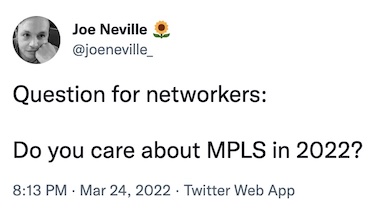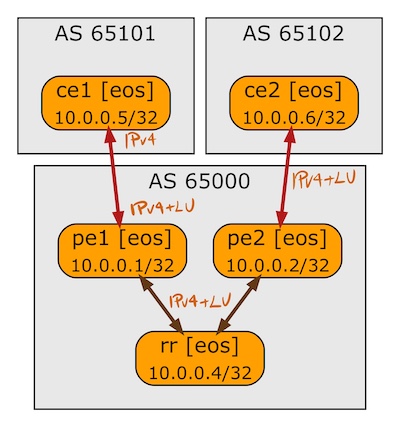Keep Blogging, Some of Us Still Read
I stumbled upon a sad tweet a few days ago…

… and not surprisingly, a lot of people chimed in saying “don’t give up, we still prefer reading”. Unfortunately, it does seem like the amount of worthy content is constantly decreasing, and way too many quality blogs disappeared over the years, so I’ll try to lift the veil of depression a bit ;)
Creating VRF Lite Labs With netlab
I always found VRF lab setups a chore. On top of the usual IPAM tasks you have to create VRFs, assign route targets and route distinguishers, do that on every PE-router in your lab… before you can start working on interesting things.
I tried to remove as much friction as I could with the netlab VRF configuration module – let me walk you through a few simple examples1 which will also serve to illustrate the VRF configuration differences between Cisco IOS and Arista EOS.
Worth Reading: Full-Stack Network Automation
Lívio Zanol Puppim published a series of blog posts describing a full-stack network automation, including GitOps with GitLab, handling secrets with Hashicorp Vault, using Ansible and AWX to run automation scripts, continuous integration with Gitlab CI Runner, and topped it off with a REST API and React-based user interface.
You might not want to use the exact same components, but it’s probably worthwhile going through his solution and explore the source code. He’s also looking for any comments or feedback you might have on how to improve what he did.
Worth Reading: The AI Illusion
Russ White’s Weekend Reads are full of gems, including a recent pointer to the AI Illusion – State-of-the-Art Chatbots Aren’t What They Seem article. It starts with “Artificial intelligence is an oxymoron. Despite all the incredible things computers can do, they are still not intelligent in any meaningful sense of the word.” and it only gets better.
While the article focuses on natural language processing (GPT-3 model), I see no reason why we should expect better performance from AI in networking (see also: AI/ML in Networking – The Good, the Bad, and the Ugly).
Video: IPv6 Trust Model
After discussing the basics of IPv6 security in the hands-on part of IPv6 security webinar webinar, Christopher Werny focused on the IPv6 trust model (aka “we’re all brothers and sisters on link-local”).
Next Hops of BGP Routes Reflected by Arista EOS
Imagine a suboptimal design in which:
- A BGP route reflector also servers as an AS edge (PE) router1;
- You want to use next-hop-self on AS edge routers.
Being exposed to Cisco IOS for decades, I considered that to be a no-brainer. After all, section 10 of RFC 4456 is pretty specific:
In addition, when a RR reflects a route, it SHOULD NOT modify the following path attributes: NEXT_HOP, AS_PATH, LOCAL_PREF, and MED.
Arista EOS is different – a route reflector happily modifies NEXT_HOP on reflected routes (but then, did you notice the “SHOULD NOT” wording?2)
Opinion: Do You Care about MPLS in 2022?
One of my readers asked for my opinion about this question…

… and I promised something longer than 280 characters.
BGP Labeled Unicast Interoperability Challenges
Jeff Tantsura left me tantalizing hint after reading the BGP Labeled Unicast on Cisco IOS blog post:
Read carefully “Relationship between SAFI-4 and SAFI-1 Routes” section in RFC 8277
The start of that section doesn’t look promising (and it gets worse):
It is possible that a BGP speaker will receive both a SAFI-11 route for prefix P and a SAFI-42 route for prefix P. Different implementations treat this situation in different ways.
Now for the details:
netlab MPLS Support
netlab release 1.2.0 adds full-blown MPLS and MPLS/VPN support:
- VRF definitions and layer-3 VRFs
- VRF-aware OSPF, IS-IS and BGP
- Traditional MPLS with LDP (SR-MPLS was already available)
- BGP Labeled Unicast
- MPLS/VPN: VPNv4 and VPNv6 address family support
It’s never been easier to build full-blown MPLS/VPN labs ;)… if you’re OK with using Cisco IOS or Arista EOS. Please feel free to submit a PR to add support for other platforms.
You might want to start with the VRF tutorial to see how simple it is to define VRFs, and follow the installation guide to set up your lab – if you’re semi-fluent in Linux, the easiest option would be to run Arista cEOS.
Worth Reading: Higher Levels of Address Aggregation
Every now and then someone tells me how much better the global Internet would be if only we were using recursive layers (RINA) and hierarchical addresses. I always answer “that’s a business problem, not a technical one, and you cannot solve business problems by throwing technology at them”, but of course that has never persuaded anyone who hasn’t been running a large-enough business for long enough.
Geoff Huston is doing a much better job in the March 2022 ISP Column – read the Higher Levels of Address Aggregation, and if you still need more technical details, there’s 30+ pages of RFC 4984.
Worth Reading: Career Advice I'd Give to Younger Me
You MUST read the next masterpiece coming from Ethan Banks: Career Advice I’d Give To 20, 30 and 40-Something Year Old Me. I found this bit particularly relevant:
Your life is at least half over. Stop wasting time doing things other people think are important.
If only Ethan would have told me that wisdom ten years ago.
Video: Combining Data-Link- and Network Layer Addresses
The previous videos in the How Networks Really Work webinar described some interesting details of data-link layer addresses and network layer addresses. Now for the final bit: how do we map an adjacent network address into a per-interface data link layer address?
If you answered ARP (or ND if you happen to be of IPv6 persuasion) you’re absolutely right… but is that the only way? Watch the Combining Data-Link- and Network Addresses video to find out.
Is MPLS/VPN Too Complex?
Henk Smit made the following claim in one of his comments:
I think BGP-MPLS-VPNs are over-complicated. And you don’t get enough return for that extra complexity.
TL&DR: He’s right (and I just violated Betteridge’s law of headlines)
The history of how we got to the current morass might be interesting for engineers who want to look behind the curtain, so here we go…
Duplicate ARP Replies with Anycast Gateways
A reader sent me the following intriguing question:
I’m trying to understand the ARP behavior with SVI interface configured with anycast gateways of leaf switches, and with distributed anycast gateways configured across the leaf nodes in VXLAN scenario.
Without going into too many details, the core dilemma is: will the ARP request get flooded, and will we get multiple ARP replies. As always, the correct answer is “it depends” 🤷♂️
BGP Labeled Unicast on Arista EOS
A week ago I described how Cisco IOS implemented BGP Labeled Unicast. In this blog post we’ll focus on Arista EOS using the same lab as before:

BGP sessions in the BGP-LU lab
